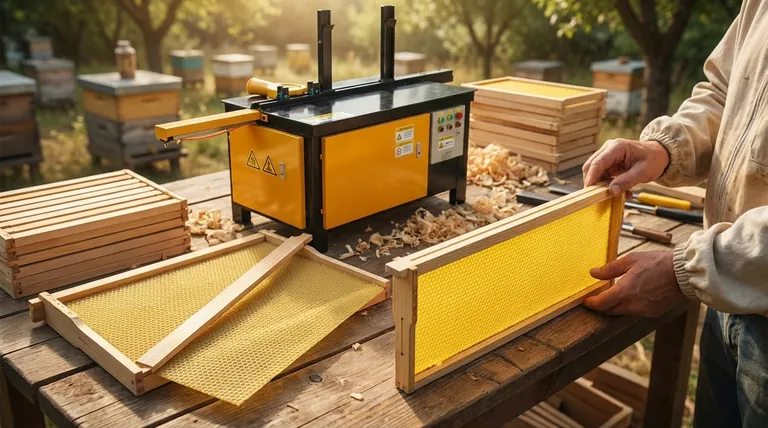Understanding the difference between wedged-top and grooved-top frames comes down to the type of foundation you plan to use. A wedged-top frame is specifically designed to hold a sheet of beeswax foundation that has support wires, while a grooved-top frame is made to easily accept a rigid sheet of plastic foundation. This choice fundamentally dictates your equipment and assembly process.
Your choice of frame is less about the wood itself and more about a commitment to a foundation system: the natural but fragile nature of beeswax, or the durable and efficient nature of plastic.

The Mechanics of Each Frame Type
The design of the top bar on a frame is the critical difference. It's engineered for a specific method of securing the foundation, which is the patterned sheet that bees use as a guide to build their honeycomb.
How Wedged-Top Frames Work
A wedged-top frame (or "wedge top") features a removable wood strip, the "wedge," in its top bar. This design is intended for use with beeswax foundation that has been reinforced with wires.
To assemble, you pry out the wedge, place the hooks of the wired foundation over the top bar, and then nail the wedge back in place, securely pinching the foundation. This method ensures the delicate wax sheet is held securely.
How Grooved-Top Frames Work
A grooved-top frame has a simple, continuous slot cut along the length of both the inner top bar and bottom bar. This system is purpose-built for plastic foundation.
Assembly is exceptionally straightforward. You simply flex the plastic foundation sheet slightly and slide it into the top and bottom grooves. There are no nails or extra pieces required, making the process significantly faster.
Foundation: The Core of the Decision
Choosing a frame type locks you into a corresponding foundation type. Understanding the characteristics of each is essential to making an informed decision for your apiary.
Wax Foundation (For Wedged Frames)
Many beekeepers prefer wax foundation because it is a completely natural material. Bees tend to accept and draw out comb on pure beeswax very readily.
However, wax foundation is fragile. It can be easily damaged during hive inspections or honey extraction and can sag or warp in very high temperatures if not properly wired and supported.
Plastic Foundation (For Grooved Frames)
Plastic foundation is valued for its extreme durability. It can withstand aggressive handling and the high rotational speeds of honey extractors without breaking. It is also resistant to damage from pests like wax moths.
While some beekeepers feel it is less "natural," most modern plastic foundation comes heavily coated in beeswax to encourage the bees to build on it. This combination offers the durability of plastic with the appeal of real wax.
Understanding the Trade-offs
Neither system is universally "better." The right choice depends on your priorities regarding time, durability, and beekeeping philosophy.
Assembly and Time
There is no contest here: grooved-top frames with plastic foundation are significantly faster and easier to assemble. This can be a major factor if you are managing a large number of hives. Wedged frames and wax foundation require more time, care, and tools.
Durability and Longevity
Plastic foundation is vastly more durable. It can be scraped clean and reused for many seasons. Wax foundation is delicate and often needs to be replaced after a few years or if it becomes damaged.
Bee Acceptance and Philosophy
Some purists argue that bees work wax foundation more eagerly and that it's better for the colony's natural development. This aligns with a more "natural beekeeping" philosophy.
Conversely, the efficiency and reliability of plastic foundation are undeniable advantages for many commercial and hobbyist beekeepers who prioritize honey production and ease of management.
Making the Right Choice for Your Apiary
Your decision should be based on your personal goals and how you plan to manage your bees.
- If your primary focus is natural beekeeping and you don't mind extra labor: Choose wedged-top frames, as they are designed for the pure beeswax foundation that aligns with this philosophy.
- If your primary focus is efficiency, durability, and ease of use: Choose grooved-top frames and plastic foundation for their speed of assembly and resilience during extraction.
Ultimately, the best frame system is the one that aligns with your management style and beekeeping goals.
Summary Table:
| Frame Type | Foundation Type | Key Characteristics |
|---|---|---|
| Wedged-Top | Beeswax (Wired) | Natural material, bee-friendly, more labor-intensive assembly, less durable |
| Grooved-Top | Plastic | Highly durable, fast assembly, reusable, great for commercial operations |
Ready to equip your apiary with the right frames?
At HONESTBEE, we supply commercial apiaries and equipment distributors with the high-quality beekeeping supplies they need to succeed. Whether you're building a new operation or scaling an existing one, we can help you choose the right frame and foundation systems for maximum efficiency and honey production.
Contact our wholesale experts today to discuss your needs and get a quote!
Visual Guide

Related Products
- HONESTBEE Bee Frame Grooving Machine | Precision Slotting for Bee Frame Making
- Wooden Bee Hive Frames for Beekeeping and Wholesale
- Copper Bee Frame Eyelets for Beekeeping
- HONESTBEE Durable Frame Wiring Board with Integrated Tensioner
- Heavy-Duty Nylon Beehive Hive Strap with Stainless Steel Cinch Buckle
People Also Ask
- What happens to honeycombs after harvest? Maximizing Resource Efficiency for Your Apiary
- What is the purpose of a small desktop bee frame forming machine? Automate Frame Assembly for Beekeepers
- How much honey can twelve bees produce in their lifetime? Discover the Astonishing Team Effort
- Why do beekeepers prefer crushed honey? Unlock a Richer, More Complex Flavor Profile
- What are the stages of development from egg to pupa in bees? A Guide to Bee Metamorphosis



















